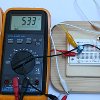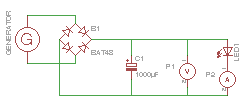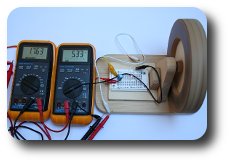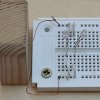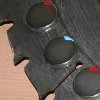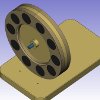Wooden Generator 1 with rectifier
Based on Wooden Generator Experiment 1, the circuit was now extended by a bridge rectifier.
For this I used BAT48 Schottky diodes because they consume only 0.2 volts.
A 1000 μF electrolytic capacitor is used as a stabilizing element.
The capacitor buffers the whole a little and the LED should light up longer and more stable.
With a small LED as a consumer, I get a current of approx. 5 mA and a voltage of approx. 1.7 V with fast speeds.
The result is a proud performance of 8.5 milliwatts.
So there is still much room for improvement :-)
The following video gives a brief impression of the rather poor yield.
https://youtube.com/watch?v=SH9jxq0oGrw%26hl%3Den%26fs%3D1

